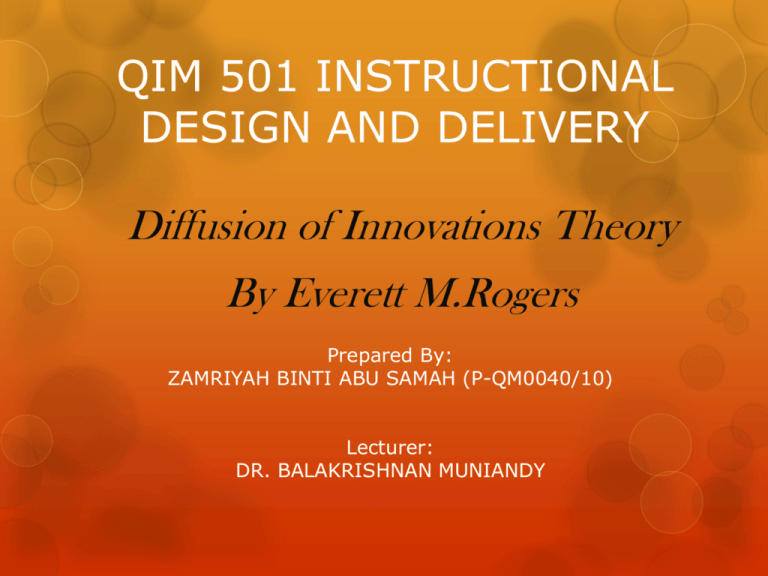PPT OF DOI - Instructional Design & delivery / 2010 + Research
advertisement

QIM 501 INSTRUCTIONAL DESIGN AND DELIVERY Diffusion of Innovations Theory By Everett M.Rogers Prepared By: ZAMRIYAH BINTI ABU SAMAH (P-QM0040/10) Lecturer: DR. BALAKRISHNAN MUNIANDY INTRODUCTION Helping an organization to adopt a new technology is not easy. Often resistance is encountered and people become frustrated. To help organizations understand this process of how an innovation (new technology) is adopted among members of a group, researcher Everett M. Roger has done extensive study of how new technologies are accepted among social groups. Rogers is the author of the well-known book, “Diffusion of Innovations.” The origins of the diffusion of innovations (DOI) theory are varied and span across multiple disciplines. Rogers identifies six main traditions that impacted diffusion research: anthropology, early sociology, rural sociology, education, industrial, and medical sociology. The diffusion of innovation theory has been largely influenced by the work of rural sociologists. In the book Diffusion of Innovations, Rogers synthesizes research from over 508 diffusion studies and produces a theory for the adoption of innovations among individuals and organization. GET TO KNOW… o Everett M. Rogers (March 6, 1931 - October 21, 2004) was a communication scholar, sociologist, writer, and teacher. o Rogers was born on the family Pinehurst Farm in Carroll, Iowa o After pursuing a degree in agriculture, Rogers earned his PhD in Sociology and Statistics at Iowa State University (1957). o His doctorate work stemmed from both his personal interest in understanding why farmers in Iowa, including his father, resisted using such new inventions in their fields as high-yielding hybrid seed corns, chemical fertilizers and weed sprays as well as how such new applications diffuse among farmers over time. What is Diffusion? According to Rogers, “Diffusion is the process in which an innovation is communicated through certain channels over time among the members of a social system” Main Elements of Diffusion The Innovation Communication Channels Time A Social System Main Elements of Diffusion The Innovation A new idea such as training, instruction, etc. an idea, practice, or object that is perceived as new by an individual or other unit of adoption Examples: PPSMI (Teaching of Science & Mathematics In English) Main Elements of Diffusion Communication Channels the means by which messages get from one individual to another Etems Course=attend by the teacher of Science & Maths to develop their skills in teaching in English Main Elements of Diffusion Time Decision process in which an innovation is adopted the length of time required to pass through the innovation-decision process PPSMI starts from 2003-2012 Main Elements of Diffusion A Social System Members of that society engaged to accomplish a common goal a set of interrelated units that are engaged in joint problem solving to accomplish a common goal Minister of Education, Educational Officers, teachers,Students, parents & Malaysian People The 5 Stages of Adoption – Decision Process Knowledge Persuasion Decision Implementation Confirmation Reject Accept KNOWLEDGE Knowledge: when an individual (or other decision-making unit) is exposed to an innovation’s existence and gains an understanding of how it functions introduced to new product In this stage the individual is first exposed to an innovation but lacks information about the innovation. During this stage of the process the individual has not been inspired to find more information about the innovation. PERSUASION Persuasion: when an individual (or other decision-making unit) forms a favorable or unfavorable attitude towards the innovation initial feelings about the product In this stage the individual is interested in the innovation and actively seeks information/detail about the innovation. DECISION Decision: when an individual (or other decision-making unit) engages in activities that lead to a choice to adopt or reject the innovation use the product or not In this stage the individual takes the concept of the innovation and weighs the advantages/disadvantages of using the innovation and decides whether to adopt or reject the innovation. Due to the individualistic nature of this stage Rogers notes that it is the most difficult stage to acquire empirical evidence DECISION Types of Innovation-Decisions Optional Innovation-Decision Collective Innovation-Decision Authority Innovation-Decision Optional Innovation-Decision This decision is made by an individual who is in some way distinguished from others in a social system. Example: In rural area school (in rural Sabah/Sarawak), teachers cannot apply PPSMI because of language & technology adoption. Collective Innovation-Decision This decision is made collectively by all individuals of a social system. Examples: In some premier school, all class have aircondition because the parents & the school itself willing to provide it. Authority Innovation-Decision This decision is made for the entire social system by few individuals in positions of influence or power. Example: The new Minister of Education has agreed to cancel the PPSMI starting on the year 2012. IMPLEMENTATION Implementation: when an individual (or other decision-making unit) puts a new technology to use use new product In this stage the individual employs the innovation to a varying degree depending on the situation. During this stage the individual determines the usefulness of the innovation and may search for further information about it. CONFIRMATION Confirmation: when an individual (or other decision-making unit) seeks to reinforce or revoke (reject) an innovationdecision ceases or continues to use the product Although the name of this stage may be misleading, in this stage the individual finalizes their decision to continue using the innovation and may use the innovation to its fullest potential. Adoption of Change The rate of adoption of innovations usually occurs in an “S” curve. The variation in the slope is due to the rapid or slower rates of adoption. Individuals who are involved with the change fall into adopter categories. Begins with slow change, it is followed by rapid change and ends in slow change (constant) as the product matures or new technologies emerge S-Curved of Diffusion Adopter Classes Innovators - 2.5% Early adopters – 13.5% Early majority – 34% Late majority – 34% Laggards – 16% Who Is The INNOVATORS? An innovator or pioneer is a person or an organisation who is one of the first to do something and often opens up a new area for others and achieves an innovation. @ the first individuals to adopt an innovation The characteristics: - willing to take risks - youngest in age - have the highest social class - have great financial lucidity - very social - have closest contact to scientific sources and interaction with other innovators Who Is The INNOVATORS? Some people that are often called innovators: Isaac Newton - pioneered classical mechanics Albert Einstein- pioneered quantum physics Sir Richard Arkwright - credited for inventing spinning frame Wright Brothers - pioneered controlled flight Thomas Edison - developed the first economically feasible light bulb Henry Ford - pioneered mass produced motor cars Isambard Kingdom Brunel - revolutionised public transport and engineering Nikola Tesla - pioneered the induction motor Robert H. Goddard - pioneered the liquid rocket engine Tim Berners Lee- invented the World Wide Web Who Is The EARLY ADOPTERS? Is an early customer of a given company, product, or technology; in politics, fashion, art, and other fields, this person would be referred to as a trendsetter. A customer who, in addition to using the vendor's product or technology, will also provide considerable and candid feedback to help the vendor refine its future product releases, as well as the associated means of distribution, service, and support. The characteristics: - have the highest degree of opinion leadership among the other adopter categories - typically younger in age, have a higher social status, have more financial lucidity, advanced education, and are more socially forward than late adopters Who Is The EARLY MAJORITY? Individuals in this category adopt an innovation after a varying degree of time This time of adoption is significantly longer than the innovators and early adopters The Characteristics: -Early Majority tend to be slower in the adoption process, have above average social status, contact with early adopters, and seldom hold positions of opinion leadership in a system Who Is The LATE MAJORITY? Individuals in this category will adopt an innovation after the average member of the society These individuals approach an innovation with a high degree of skepticism and after the majority of society has adopted the innovation. The Characteristics: -Late Majority are typically skeptical about an innovation, have below average social status, very little financial lucidity, in contact with others in late majority and early majority, very little opinion leadership Who Is The LAGGARDS? Individuals in this category are the last to adopt an innovation Unlike some of the previous categories, individuals in this category show little to no opinion leadership. The Characteristics: -have an aversion to change-agents and tend to be advanced in age. -tend to be focused on “traditions”, have lowest social status, lowest financial fluidity, oldest of all other adopters, in contact with only family and close friends, very little to no opinion leadership. How does this relate to Instructional Design & Technology? Understand why certain technologies are adopted while others are not. Don’t just blame the teachers. Be able to utilize this theory in introducing and adopting new technologies in your own school. Create a model to use in systematically implementing new innovations in the future. What to Consider About the Innovation: Relative Advantage: how much better is it? Compatibility: meet a need or improve an existing product Complexity: easy to use? Trialability: way to try it out Observability: can you see results? How To Adopt Innovations in Instructional Design Field: 5 steps of Burkman's User Oriented Instructional Development process: 1. Identify the potential adopter 2. Measure relevant potential adopter perceptions 3. Design and develop a user-friendly product 4. Inform the potential adopter (of the product's userfriendliness) 5. Provide Post Adoption Support Examples of Innovations In Education Web-based education Digital Learning Environments – using technology to fundamentally redesign the learning experience in ways that lead to increased student engagement and academic success; can include innovations in online learning, virtual worlds, gaming for learning, and simulations CONCLUSION An instructional technologist & designers who understands the innovation process and theories of innovation diffusion will be more fully prepared to work effectively with clients and potential adopters. The study of diffusion theory could lead to the development of a systematic, prescriptive model of adoption and diffusion. Instructional technologists & designers have long used systematic models to guide the process of instructional development (ID). These systematic ID models have resulted in the design and development of effective and pedagogically sound innovations. A systematic model of diffusion could help guide the process of adoption and diffusion in a similar manner and, perhaps, with similarly effective results. REFERENCES Rogers, Everett M.(1962). Diffusion of Innovations. Free Press of Glencoe, Macmillan Company. Rogers, Everett M. (1983). Diffusion of Innovations. New York: Free Press. http://en.wikipedia.org/wiki/Diffusion_of_innovations http://www.zonalatina.com/Zldata99.htm http://www.futurelab.org.uk/ http://www.newhorizons.org/strategies/technology/front_tech.htm o http://www2.gsu.edu/~wwwitr/docs/diffusion/ Rogers, Everett M. "New Product Adoption and Diffusion". Journal of Consumer Research. Volume 2 March 1976 pp. 290 -301. Center for Educational Technology. (1989).Schoolyear 2000: Models for excellence. Tallahassee, FL: Center for Educational Technology, Florida State University. THAT’S ALL Thank You







